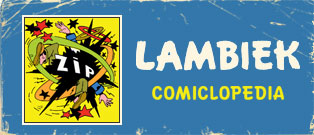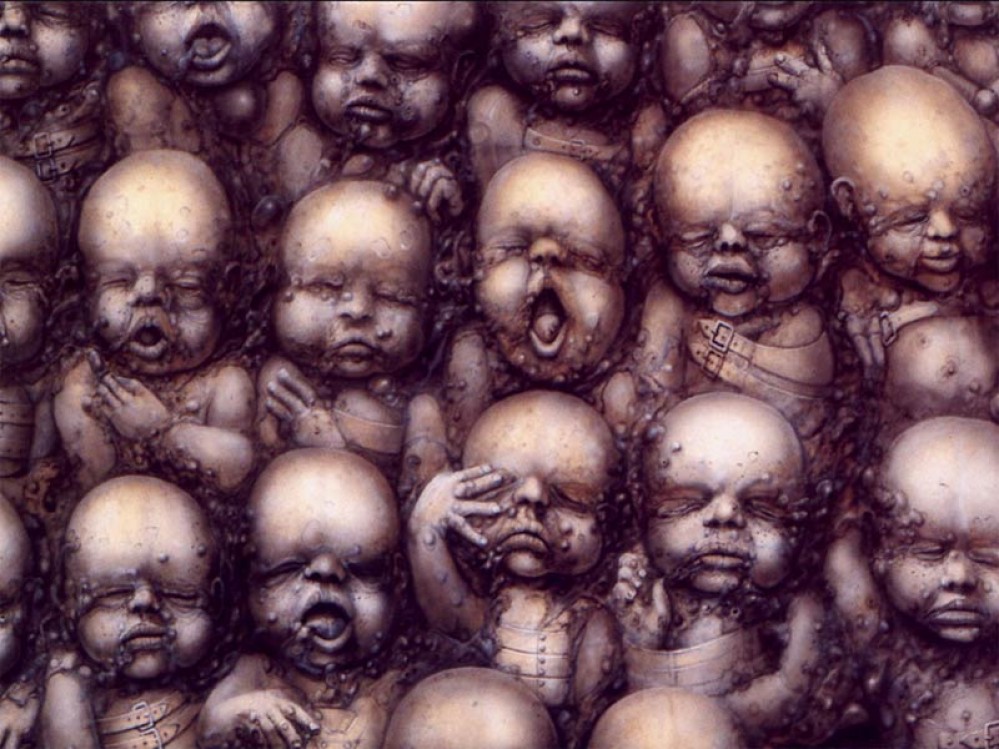H.R. Giger is famous for his claustrophobic paintings and illustrations which combine the human body with all kinds of mechanical devices. Many images have a disturbing sexual and morbid undertone. The cult artist gained further fame as illustrator of various rock album covers and the designer of the extraterrestrials in the horror film franchise 'Alien'.
Hans Ruedi Giger, who used the artist name H.R. Giger, was born in 1940 to a chemist's family in Chur, Switzerland. In 1962, he moved to Zürich, where he studied architecture and industrial design at the School of Applied Arts. By 1964, he was producing his first artworks, mostly ink drawings and a few oils, leading to his first solo exhibition in 1966, followed by the publication and world-wide distribution of his first poster edition in 1969. Shortly after that, he discovered the airbrush and, along with it, his own unique freehand painting style, leading to the creation of many of his best-known works, the surrealistic bio-mechanical dreamscapes which formed the cornerstone of his fame.
His nightmarish paintings and drawings were a result from his own chronic "night terrors", a sleep disorder which causes feelings of terror or dread. Whenever Giger awoke from one of these intense nightmares he started drawing out his dreams on paper. He tried to analyze them through therapy and by studying the works of Sigmund Freud and Carl Gustav Jung. This also explains his interest in writers like Jean-Paul Sartre, Albert Camus, Samuel Beckett, Franz Kafka, David Lynch and Ingmar Bergman, and painters like Dado, Ernst Fuchs, Salvador Dalí, Austin Osman Spare, Stanislas Szukalski and Mati Klarwein. Giger also had quite some traumatic experiences as a child, which may have contributed to his bad dreams. His father once gave him a human skull for his birthday. His mother often put him into an multi-buttoned overall which was difficult to open. Whenever the boy had to go to the bathroom it took so long to unbutton everything that he usually just soiled himself. Giger also once visited his grandmother's grave where the sight of a worm crawling out of the sand gave him a lifelong phobia for anything resembling worms, like snakes, garden hoses and tubes. The artist also feared torture and dismembered limbs, but at the same time he was fascinated by his fears as well.
Because of their disturbing look Giger's paintings sold very well. He was a frequent cover illustrator for Métal Hurlant (Heavy Metal) and a much-sought after album cover designer. He designed the covers of metal bands like The Shiver ('Walpurgis', 1969), Celtic Frost ('To Mega Therion', 1985), Atrocity ('Hallucinations' 1990), Danzig ('Danzig III: How the Gods Kill', 1992), Carcass ('Heartwork', 1993) and Triptykon ('Eparistera Daimones', 2010 and 'Melana Chasmata', 2014). His art also graced the covers of 'Brain Salad Surgery' (1973) by Emerson, Lake & Palmer, 'Mumien' (1974) by Floh de Cologne, 'Attahk' (1978) by Magma, 'KooKoo' (1981) by Blondie, 'Atomic Playboys' (1989) by Steve Stevens, and 'Hide Your Face' (1994) by hide. Giger's album covers for Debbie Harry and Emerson, Lake & Palmer's were voted among the 100 best in music history in a survey of rock journalists. His painting 'Landscape XX' (1973), which depicts self-sodomising penises, was used as the cover of 'Frankenchrist' (1985) by the American punk band Dead Kennedys. The piece lead to an obscenity trial, since it was released at the height of the media frenzy over music censorship in the United States. The Parents Music Resource Center (PMRC) objected to the cover and filed a lawsuit against the band because of "harmful matter to minors". The group eventually won the case, but nearly went bankrupt from paying their lawyers. And still many U.S. record stores either used a different cover for the album or downright refused to sell it. Giger also directed music videos for Blondie ('Backfired', 1981, and 'Now I Know You Know', 1981) and Böhse Onkelz ('Dunkler Ort', 2000). He furthermore designed a special microphone stand for Korn frontman Jonathan Davis.
In the early 1970s Giger got involved in his first cinematic project: a film adaptation of Frank Herbert's SF novel 'Dune', which would be directed by Alejandro Jodorowsky. Giger's involvement with this plot about a giant space worm was surprising, since the artist's phobia for worms. Giger, Chris Foss and Jean Giraud designed sets and characters, Dan O'Bannon provided special effects and David Carradine, Mick Jagger, Gloria Swanson, Salvador Dalí, Amanda Lear and Orson Welles were set to play major roles. The soundtrack would be composed by Pink Floyd and Magma. This ultimate geek's wet dream was unfortunately never realized since Jodorowsky couldn't find proper funding. Instead David Lynch directed the picture and in terms of huge stars they had to settle for Brad Dourif, José Ferrer, Patrick Stewart, Max von Sydow and Sting. The soundtrack was provided by Brian Eno and the band Toto. 'Dune' (1984) was a huge critical and commercial flop upon its release. Lynch always regarded it as an old shame. One of the few people to like it was SF writer Harlan Ellison. Today the reception to 'Dune' has warmed up and it garnered a cult following. In 2013 an interesting documentary about Jodorowsky's project, 'Jodorowsky's Dune', was released by Frank Pavich.
In 1979 Giger attached a more succesful science fiction franchise to his name: 'Alien'. This SF horror film centered around an extraterrestrial alien who manages to get on board of a spaceship and then murders every crew member one by one. Director Ridley Scott based it on the paintings 'Necronom IV' and 'Necronom V' in Giger's first book 'Necronomicon' (Sphinx, 1977), which showed a humanoid creature with a huge phallic-shaped head. The creature was designed by Giger while Dan O'Bannon made a real-life model out of it. Giger also created the interior of the abandoned spacecraft the crew finds at the start of the picture, as well as the alien's egg chamber. The mysterious "space jockey" - a deceased alien creature sitting inside a cockpit - was also his work. Among the many influences for the frightening atmosphere were not only science fiction horror novels and films, but also Al Feldstein and William M. Gaines' EC Comics. Moebius was also involved with the production and made a few designs for the costumes, which were then further worked out by costume designer John Mollo. 'Alien' quickly gained a cult following and got good reviews. Giger won a shared 1980 Oscar for Best Visual Effects. The film was also adapted into a comic strip, published in Métal Hurlant (Heavy Metal) as 'Alien: The Illustrated Story' (1979), but without Giger's participation. Instead it was written by Archie Goodwin, lettered by John Workman and illustrated by Walt Simonson. The comic was an unexpected best-seller, even becoming the first graphic novel to end up in the New York Times Best Seller list!
H.R. Giger concept art for the Facehugger from Alien
'Alien' received a sequel in 1986, 'Aliens' (1986), but the tone was vastly different, being more like an action-packed blockbuster where a crew has to fight off hundreds of aliens instead of just one. Giger was not involved with it, but did create some designs for the next sequel, 'Alien 3' (1992). In 1997 a fourth film came out, 'Alien: Resurrection' (1997), which inexplicably left his name off the credits. Giger wrote 20th Century Fox an angry letter of complaint, which he signed off with the words: "As for those responsible for this conspiracy: All I can wish them is an Alien breeding inside their chests, which might just remind them that the "Alien Father" is H.R. Giger." Giger had nothing to do with all other 'Alien' sequels and prequels that followed, though he did receive his credits back. A true testament to his iconic designs is that nearly every science fiction horror film that followed ripped him off, from the aliens in 'Predator' (1987) to the ones in 'Independence Day' (1996).
By this time the 'Alien' franchise had become so succesful that Dark Horse Comics started a long-running series of comic book adaptations, mostly based on the action-packed tone of 'Aliens' and its many sequels. The first of these titles appeared in 1986 and was written by Mark Verheiden with illustrations by Mark A. Nelson and Ron Randall. And naturally, whenever something becomes a phenomenon it will be spoofed by Mad Magazine. In 1980 'Alien' was parodied as 'Alias', with jokes written by Dick Debartolo and artwork by Mort Drucker. Debartolo also wrote the script for Mad's parodies of 'Aliens' ('Alienators', 1986) and 'Alien Resurrection' ('Alien Resuscitated', 1997), but Drucker only illustrated 'Alien Resuscitated'. The artwork for 'Alienators' was done by Jack Davis. Inexplicably the magazine never spoofed 'Alien 3', nor any of the further 'Alien' sequels.
Concept art for the never produced film The Tourist
Giger's other film work includes 'Poltergeist II' (1986) and 'Species' (1995). He was furthermore creative consultant for 'Kondom des Grauens' (1996), a film based on the eponymous comic by Ralf König. Giger would have been involved with 'Batman and Robin' (1995), a film based on the 'Batman' franchise of DC Comics, for which he made designs of the Batmobile, but they weren't used in the final picture. Throughout his career, Giger also worked as a sculptor, and in 1992, he created his first total environment, the Giger Bar in Chur. The Museum H.R. Giger in Château Saint-Germain was opened in Gruyères in 1998. The artist lived and worked in Zürich with his wife, Carmen Maria Scheifele Giger, who is the Director of the H.R. Giger Museum. Giger passed away on 12 May 2014 at the age of 74, as a result of injuries sustained in a fall.
Giger inspired the graphics of the video games 'Dark Seed' and 'Dark Seed II'. He was an influence on Rod Kierkegaard Jr., Anne Guillard, Yoshihiro Togashi and José O. Ladrönn. The artist also drew respect from Salvador Dalí and Albert Hoffmann, the scientist who discovered LSD. Harlan Ellison described Giger as "our latter day Hieronymus Bosch, the Dutch fabulist come again, demonic and erotic." Film director Oliver Stone said about him: "I do not know anybody else who has so accurately portrayed the soul of modern humanity. A few decades from now when they talk about twentieth century, they will think of Giger."
For those people interested in Giger's work Stanislav Grov's analysis, 'The Visual World of H.R. Giger' (2011) is a must-read.










